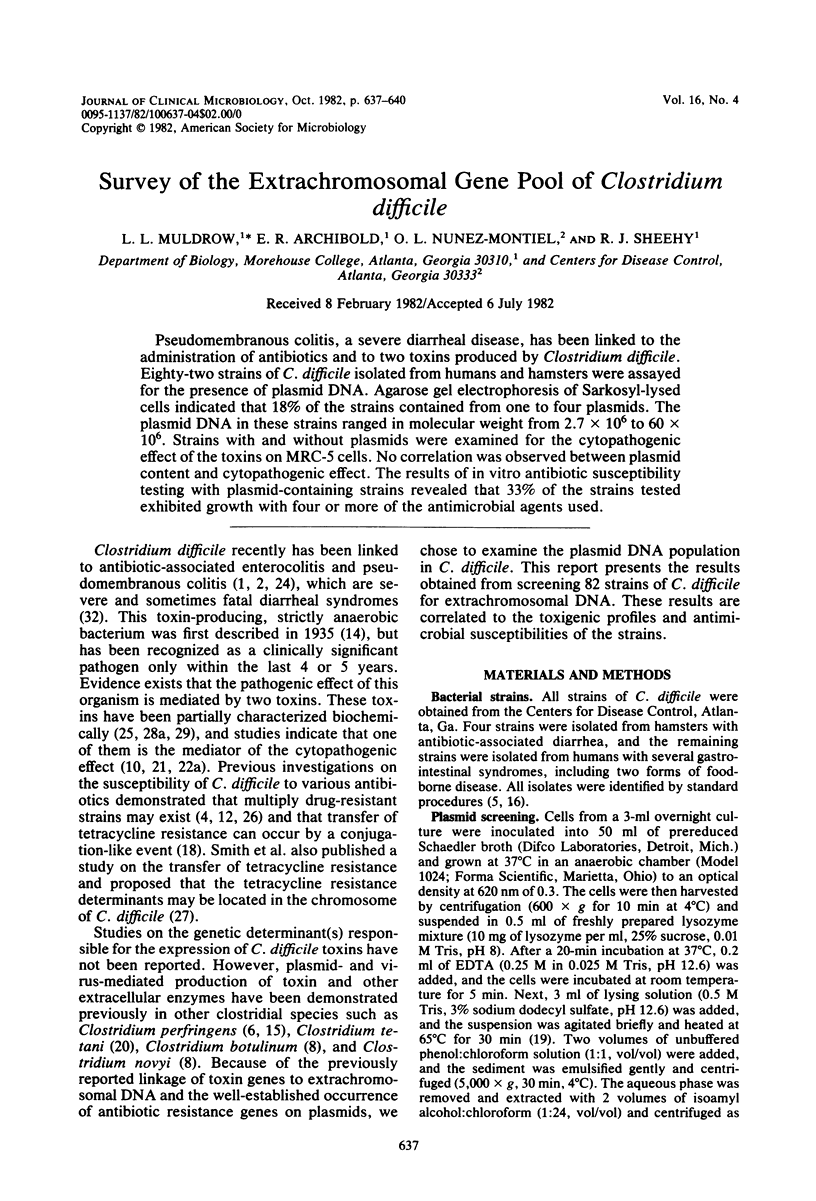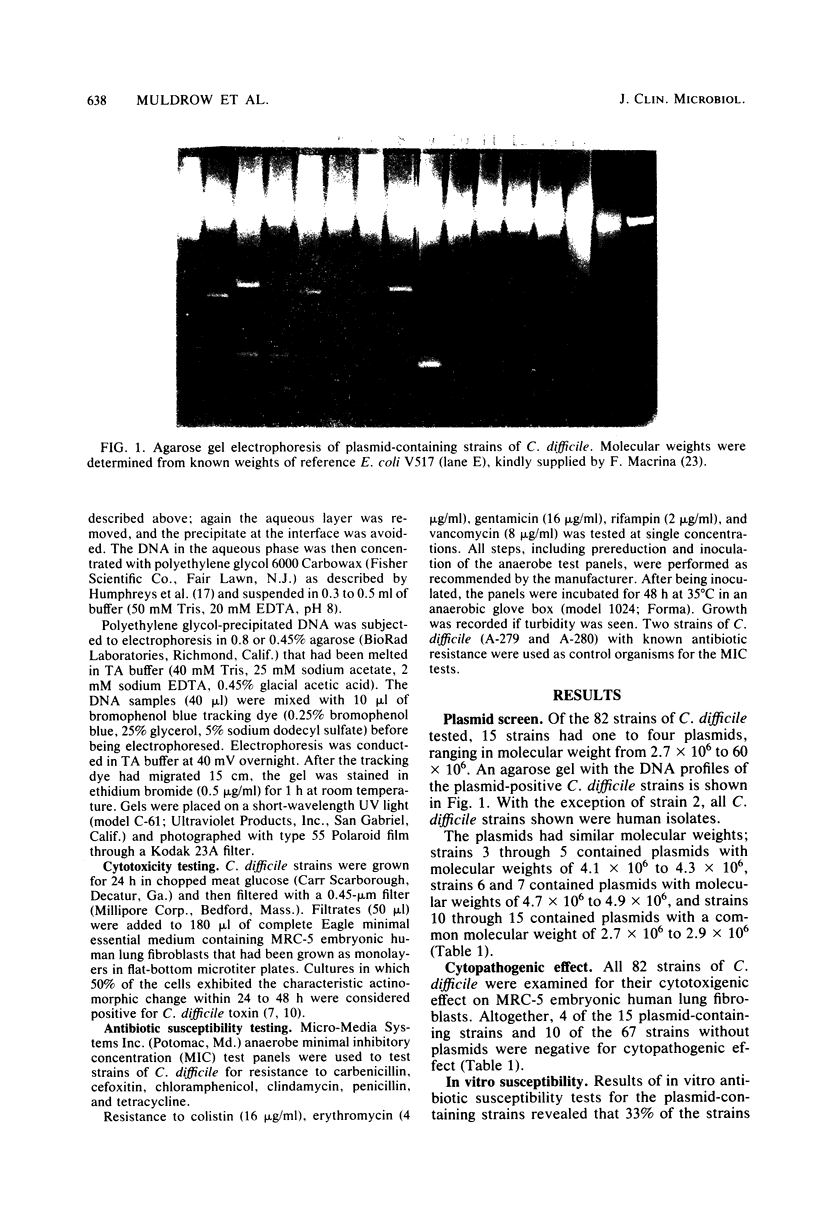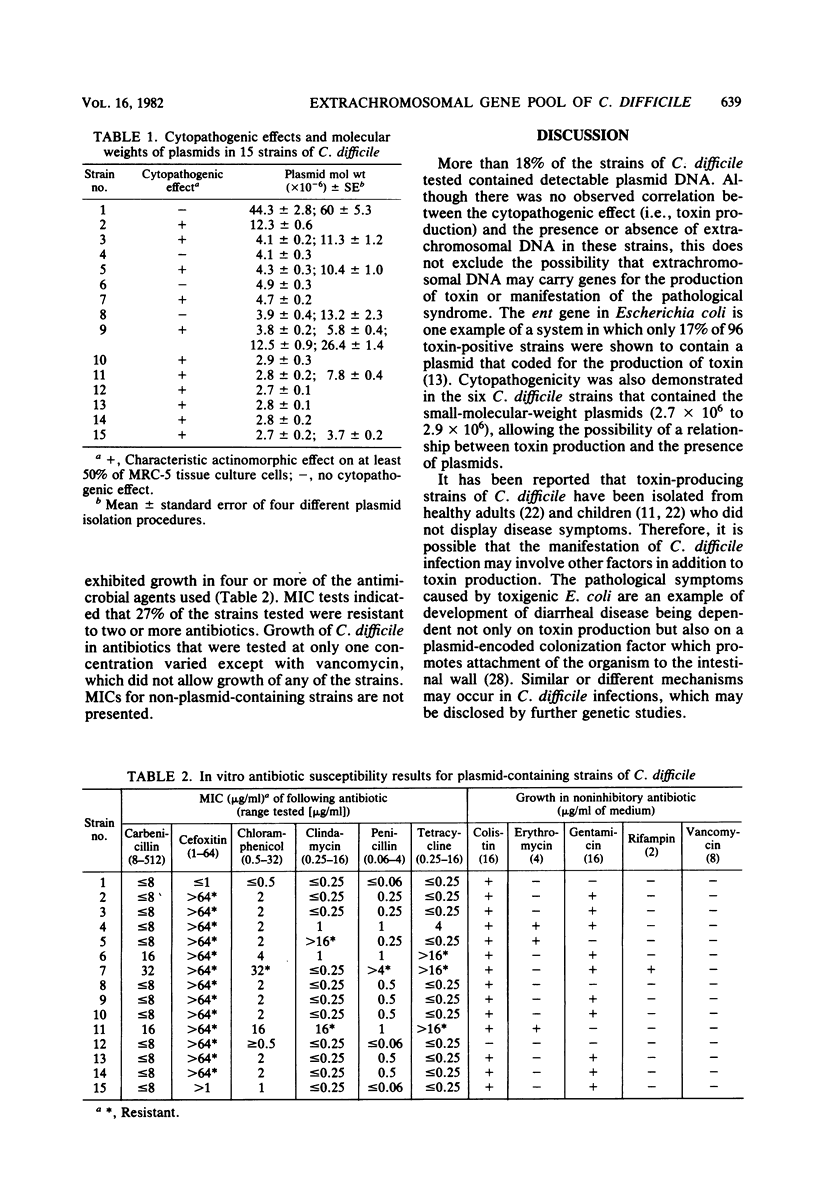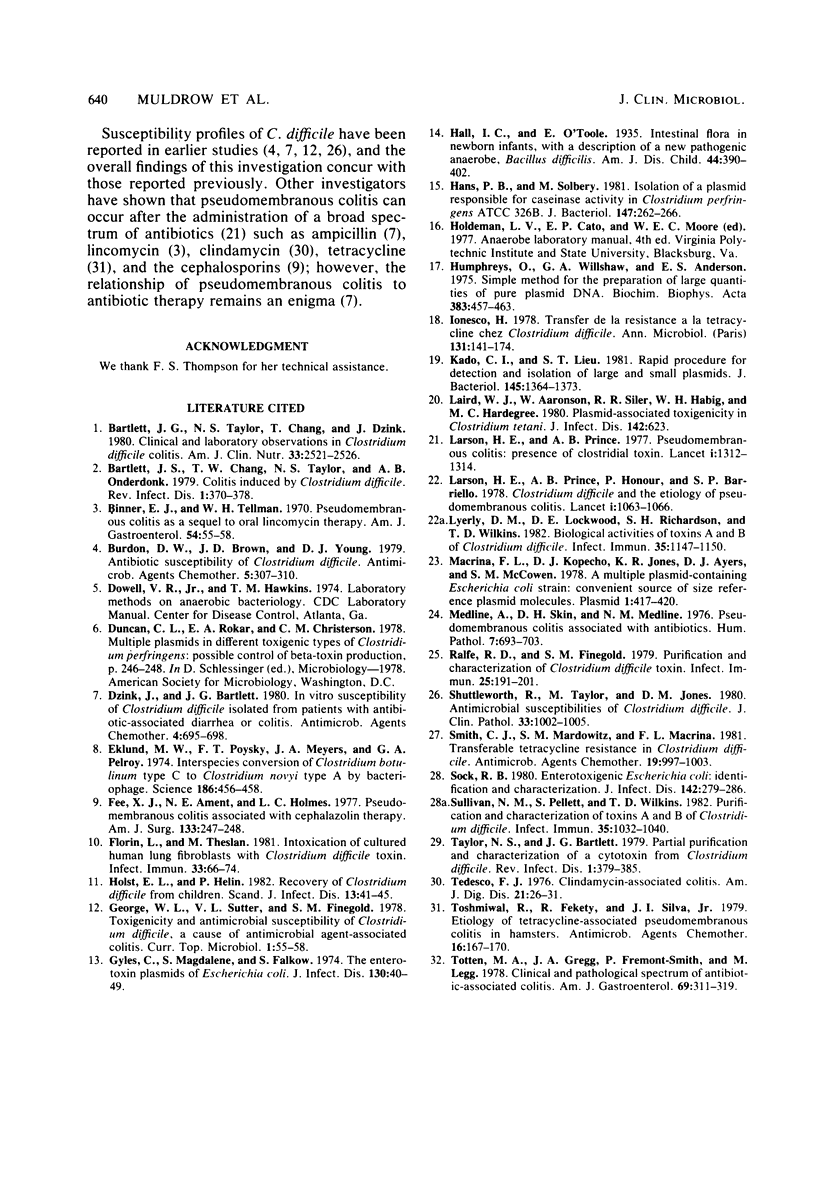Abstract
Pseudomembranous colitis, a severe diarrheal disease, has been linked to the administration of antibiotics and to two toxins produced by Clostridium difficile. Eighty-two strains of C. difficile isolated from humans and hamsters were assayed for the presence of plasmid DNA. Agarose gel electrophoresis of Sarkosyl-lysed cells indicated that 18% of the strains contained from one to four plasmids. The plasmid DNA in these strains ranged in molecular weight from 2.7 X 10(6) to 60 X 10(6). Strains with and without plasmids were examined for the cytopathogenic effect of the toxins on MRC-5 cells. No correlation was observed between plasmid content and cytopathogenic effect. The results of in vitro antibiotic susceptibility testing with plasmid-containing strains revealed that 33% of the strains tested exhibited growth with four or more of the antimicrobial agents used.
Full text
PDF



Images in this article
Selected References
These references are in PubMed. This may not be the complete list of references from this article.
- Bartlett J. G., Chang T., Taylor N. S., Onderdonk A. B. Colitis induced by Clostridium difficile. Rev Infect Dis. 1979 Mar-Apr;1(2):370–378. doi: 10.1093/clinids/1.2.370. [DOI] [PubMed] [Google Scholar]
- Bartlett J. G., Taylor N. S., Chang T., Dzink J. Clinical and laboratory observations in Clostridium difficile colitis. Am J Clin Nutr. 1980 Nov;33(11 Suppl):2521–2526. doi: 10.1093/ajcn/33.11.2521. [DOI] [PubMed] [Google Scholar]
- Benner E. J., Tellman W. H. Pseudomembraneous colitis as a sequel to oral lincomycin therapy. Am J Gastroenterol. 1970 Jul;54(1):55–58. [PubMed] [Google Scholar]
- Blaschek H. P., Solberg M. Isolation of a plasmid responsible for caseinase activity in Clostridium perfringens ATCC 3626B. J Bacteriol. 1981 Jul;147(1):262–266. doi: 10.1128/jb.147.1.262-266.1981. [DOI] [PMC free article] [PubMed] [Google Scholar]
- Burdon D. W., Brown J. D., Youngs D. J., Arabi Y., Shinagawa N., Alexander-Williams J., Keighley M. R., George R. H. Antibiotic susceptibility of Clostridium difficile. J Antimicrob Chemother. 1979 May;5(3):307–310. doi: 10.1093/jac/5.3.307. [DOI] [PubMed] [Google Scholar]
- Dzink J., Bartlett J. G. In vitro susceptibility of Clostridium difficile isolates from patients with antibiotic-associated diarrhea or colitis. Antimicrob Agents Chemother. 1980 Apr;17(4):695–698. doi: 10.1128/aac.17.4.695. [DOI] [PMC free article] [PubMed] [Google Scholar]
- Eklund M. W., Poysky F. T., Meyers J. A., Pelroy G. A. Interspecies conversion of Clostridium botulinum type C to Clostridium novyi type A by bacteriophage. Science. 1974 Nov 1;186(4162):456–458. doi: 10.1126/science.186.4162.456. [DOI] [PubMed] [Google Scholar]
- Fee H. J., Ament M. E., Holmes E. C. Pseudomembranous colitis associated with cephazolin therapy. Am J Surg. 1977 Feb;133(2):247–248. doi: 10.1016/0002-9610(77)90092-7. [DOI] [PubMed] [Google Scholar]
- Florin I., Thelestam M. Intoxication of cultured human lung fibroblasts with Clostridium difficile toxin. Infect Immun. 1981 Jul;33(1):67–74. doi: 10.1128/iai.33.1.67-74.1981. [DOI] [PMC free article] [PubMed] [Google Scholar]
- Gyles C., So M., Falkow S. The enterotoxin plasmids of Escherichia coli. J Infect Dis. 1974 Jul;130(1):40–49. doi: 10.1093/infdis/130.1.40. [DOI] [PubMed] [Google Scholar]
- Holst E., Helin I., Mårdh P. A. Recovery of Clostridium difficile from children. Scand J Infect Dis. 1981;13(1):41–45. doi: 10.1080/00365548.1981.11690365. [DOI] [PubMed] [Google Scholar]
- Humphreys G. O., Willshaw G. A., Anderson E. S. A simple method for the preparation of large quantities of pure plasmid DNA. Biochim Biophys Acta. 1975 Apr 2;383(4):457–463. doi: 10.1016/0005-2787(75)90318-4. [DOI] [PubMed] [Google Scholar]
- Kado C. I., Liu S. T. Rapid procedure for detection and isolation of large and small plasmids. J Bacteriol. 1981 Mar;145(3):1365–1373. doi: 10.1128/jb.145.3.1365-1373.1981. [DOI] [PMC free article] [PubMed] [Google Scholar]
- Laird W. J., Aaronson W., Silver R. P., Habig W. H., Hardegree M. C. Plasmid-associated toxigenicity in Clostridium tetani. J Infect Dis. 1980 Oct;142(4):623–623. doi: 10.1093/infdis/142.4.623. [DOI] [PubMed] [Google Scholar]
- Larson H. E., Price A. B., Honour P., Borriello S. P. Clostridium difficile and the aetiology of pseudomembranous colitis. Lancet. 1978 May 20;1(8073):1063–1066. doi: 10.1016/s0140-6736(78)90912-1. [DOI] [PubMed] [Google Scholar]
- Lyerly D. M., Lockwood D. E., Richardson S. H., Wilkins T. D. Biological activities of toxins A and B of Clostridium difficile. Infect Immun. 1982 Mar;35(3):1147–1150. doi: 10.1128/iai.35.3.1147-1150.1982. [DOI] [PMC free article] [PubMed] [Google Scholar]
- Macrina F. L., Kopecko D. J., Jones K. R., Ayers D. J., McCowen S. M. A multiple plasmid-containing Escherichia coli strain: convenient source of size reference plasmid molecules. Plasmid. 1978 Jun;1(3):417–420. doi: 10.1016/0147-619x(78)90056-2. [DOI] [PubMed] [Google Scholar]
- Medline A., Shin D. H., Medline N. M. Pseudomembranous colitis associated with antibiotics. Hum Pathol. 1976 Nov;7(6):693–703. doi: 10.1016/s0046-8177(76)80080-9. [DOI] [PubMed] [Google Scholar]
- Rolfe R. D., Finegold S. M. Purification and characterization of Clostridium difficile toxin. Infect Immun. 1979 Jul;25(1):191–201. doi: 10.1128/iai.25.1.191-201.1979. [DOI] [PMC free article] [PubMed] [Google Scholar]
- Sack R. B. Enterotoxigenic Escherichia coli: identification and characterization. J Infect Dis. 1980 Aug;142(2):279–286. doi: 10.1093/infdis/142.2.279. [DOI] [PubMed] [Google Scholar]
- Shuttleworth R., Taylor M., Jones D. M. Antimicrobial susceptibilities of Clostridium difficile. J Clin Pathol. 1980 Oct;33(10):1002–1005. doi: 10.1136/jcp.33.10.1002. [DOI] [PMC free article] [PubMed] [Google Scholar]
- Smith C. J., Markowitz S. M., Macrina F. L. Transferable tetracycline resistance in Clostridium difficile. Antimicrob Agents Chemother. 1981 Jun;19(6):997–1003. doi: 10.1128/aac.19.6.997. [DOI] [PMC free article] [PubMed] [Google Scholar]
- Sullivan N. M., Pellett S., Wilkins T. D. Purification and characterization of toxins A and B of Clostridium difficile. Infect Immun. 1982 Mar;35(3):1032–1040. doi: 10.1128/iai.35.3.1032-1040.1982. [DOI] [PMC free article] [PubMed] [Google Scholar]
- Taylor N. S., Bartlett J. G. Partial purification and characterization of a cytotoxin from Clostridium difficile. Rev Infect Dis. 1979 Mar-Apr;1(2):379–385. doi: 10.1093/clinids/1.2.379. [DOI] [PubMed] [Google Scholar]
- Tedesco F. J. Clindamycin-associated colitis. Review of the clinical spectrum of 47 cases. Am J Dig Dis. 1976 Jan;21(1):26–32. doi: 10.1007/BF01074135. [DOI] [PubMed] [Google Scholar]
- Toshniwal R., Fekety R., Silva J., Jr Etiology of tetracycline-associated pseudomembranous colitis in hamsters. Antimicrob Agents Chemother. 1979 Aug;16(2):167–170. doi: 10.1128/aac.16.2.167. [DOI] [PMC free article] [PubMed] [Google Scholar]
- Totten M. A., Gregg J. A., Fremont-Smith P., Legg M. Clinical and pathological spectrum of antibiotic-associated colitis. Am J Gastroenterol. 1978 Mar;69(3 Pt 1):311–319. [PubMed] [Google Scholar]



